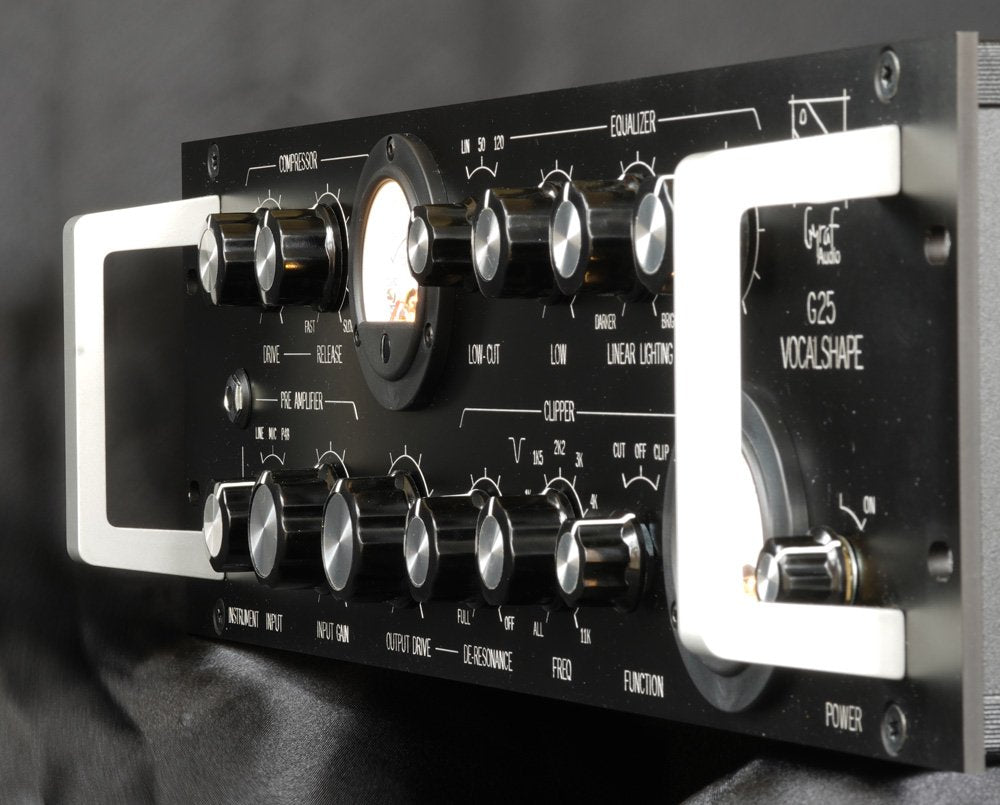G25
Delivery & Shipping
Delivery & Shipping
Free Shipping in Canada with orders over $200. Conditions apply. View details here.
Financing
Financing
Affirm
Break your purchase into easy monthly payments, quick approval and no hidden fees.
Click here for more info.
Equilease
Ideal for larger purchases, Equilease offers customized leasing solutions to fit your business needs.
Click here for more info.
Returns & Policy
Returns & Policy
You can review our terms and conditions here
Description
Description
The G25 "VocalShape" is our elaborate all-in-one box for vocal recording. It is an all-tube unit, consisting of a preamplifier stage, a filter and an equalizer section, a compressor, and finally a single stage of frequency-selective clipping for control of resonances. Every and all parameters optimized for " and only for " recording vocals.
First of all this is a tube device: All active functions, all amplification stages processing your signal are based on old-fashioned thermionic valves. This means that the unit usually will take 10-15 minutes from power-on before stabilizing into its working conditions. You can off course still use it during this time, but don't expect too much precision or predict-ability before it's settled.
So it's a tube pre-amplifier, followed by a tube equalizer, feeding a vari-mu tube compressor, which in turn drives the output stage containing a single band of passive frequency-selective clipping.
Preamplifier The topology of the G25 preamplifier is very much like our classic G9, in a version optimized for high-gain frame-grid tubes (6N23P/E88CC).
"INPUT" Switch selects between Line, Mic, and Mic+P48. The" GAIN" switch controls the amount of gain applied " ca. 4bB steps.
Mic/Line Inputs are floating transformer balanced, Line load is ca. 10K Ohms, Mic load ca. 2K Ohms. 48V Phantom power can be switched on only to the Mic input " for phantom powering condenser microphones that may need this.
The Instrument input jack on the front is a very-high-Z input that simply interrupts the connection to back panel Mic/Line connectors when a jack is inserted. The addition of this Instrument input was possible without in any way compromising the units usability for vocal recordings " it's a left-over from early revisions that is kept in place because of popular demand " several of our test drivers insists on its qualities for processing certain instruments. Ymmw.
Mic gain maxes at a bit more than +70dB, plenty for your old beaten-up SM7, and happy with anything louder. Line gain is generally some 27dB under Mic gain setting, Instrument input gain some 17dB under mic. With all knobs set to 12 o'clock, we see some +48dB gain in mic mode, +21dB in line mode
Equalizer Eq section consists of a first-order HPF @ 50Hz or 120Hz, a High/Low shelving symmetric boost/cut Bax at 6dB/Oct combined with the Linear Tilt circuit from our G23 " adjustable between +/- zero and one dB/Oct at its extremes.
Vari-mu Compressor Copied from the G10, off course. Fixed ca. 20ms Attack, variable Release some 50ms-1.6sec . Threshold and Ratio functions are combined into one knob labeled unified "Drive". Gain reduction read-out on meter.
De-resonance/Clipper This stage, which is integrated into the unit's output transformer " and thus comes after the "Output Drive" control pot, is our frequency-selective clipping circuit. The topology is a simplified version of the G21 Infundibulum " with a handful of switchable frequency ranges selected for their usefulness for helping vocal trouble. The "ALL" position is simple full-spectrum schottky diode clipping.
The "Function" switch can bypass this stage or put it into one of two modes: In "CUT" mode, the circuit acts like a subtractive eq, allowing you to turn down parts of the spectrum. In CUT mode, the clip meter is not active. "CUT" is also a useful mode for finding the frequencies that you potentially want to deal away with. Now, if you find something annoying then put the "Function" into "CLIP", the de-resonance stage will remove that part of your frequency range, but only when you are above a certain threshold, some set amount of build-up in that spectral area. In other words, you can home in and remove annoyances almost like a dynamic Eq. The "De-resonance" pot controls how much you activate this function " it both controls the threshold of onset of the clipping and the ratio of removal. As this function only subtracts, i.e. turn down signal, the knob logically goes from off/neutral at fully clockwise "turned up" to full-removal at counterclockwise "turned down". Note that the "De-resonance" pot works in concert with the "Output Drive" " being placed at the output of the unit, reacting to the absolute output level, it's dependent on both settings. The "CLIP" / "ResoSculpt" meter is indicating how much energy you are removing from your signal " but for technical reasons (it's passive after all..) the readout is an absolute value, not a relative one like the dB GR-meter for the vari-mu compressor. This means that minor movement at lower levels may well indicate more relative "action" than a lot of movement at high operating levels. In other words, don't get too focused on precise amounts of needle-movement here " unless you know your source and its operating levels well.
Specifications
Specifications
Payment & Security
Your payment information is processed securely. We do not store credit card details nor have access to your credit card information.




